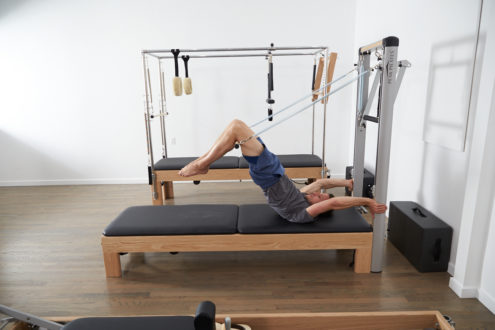The Roll Up, The Roll Over, Spine Stretch Forward. The C-Curve is used over and over in classical Pilates— not just on the mat but on most apparatus as well. The C-Curve can be defined as the shape the spine assumes that is created by the deep pull of the transverse abdominis combined with the strong lift of the spinal column in flexion. A correctly performed C-Curve increases spinal mobility and strength.
So teach students how to perform a good C-Curve, as it reverberates throughout the entire work. Understanding the do’s and don’ts of this position will help you to help your students’ progress this Shape in Space in myriad ways.
Tips for Success:
Set up strong: Work to carve out a capital letter “C” and to create a long, lifted and even arc throughout the spine. The C-Curve is initiated by lifting up and over rather than by pressing the spine backwards.
Execute: When moving into or through a C-Curve, areas of tightness may be observed. Think of these as areas of opportunity that need the most opening. You might occasionally pause during the last rep in the tightest area to provide more stretch. Remember that by simply working in a C-Curve correctly provides a great opportunity for increasing spinal flexibility.
Keep the lift: Don’t allow your body to sag and drop. Use the abdominals to maintain axial elongation and move. Imagine a string on the navel and pull the string up and back toward the scapulae when in a C-Curve.
The eyes follow the spine: If the gaze is incorrect, so too will the C -Curve be incorrect. Keep the eyes in the C-Curve pulled downward.
Trouble Shooting:
The C-Curve is frequently performed incorrectly, which at best minimizes benefit and at worst causes injury. Common errors include incorrect initiation, misalignments of the head/neck, and collapsing in the chest and rolling the shoulders up and forward.
Head/Neck: Students often hang their head forward in this position as though they were heading to the chopping block! Cue ‘be glad not sad,’ ‘Keep your neck long and elegant!” Teach students to keep the back of the head in line with the spine, reach out through the crown of their head, and flare their cobra hood… Experiment to find the cues that resonate with each student. A good tactile cue is to place your elbow lightly between their shoulder blades and place your hand on the back of their head. Then ask the student to move into you or away from you as needed.
Collapsing into the chest often results when students initiate from their upper back versus low in the powerhouse. This will impede not only the shape but the ability to breathe deeply. No hunch, no crunch, instead lift and open.
The shoulders will often roll forward and/or up, closing off the neck and creating unwanted tension. This often happens with beginners who have not developed a strong powerhouse connection. Correct this from the powerhouse and give a releasing touch if needed to allow the shoulders to rest on the powerhouse.
Building Blocks: If a student is severely tight in the low back and hamstrings, you might benefit from having them bend their knees and/or elevate their hips slightly.
Contraindications: Not every exercise or exercise position is appropriate for every student. With regard to the C-Curve, students with osteoporosis, stenosis, and other conditions where flexion is contraindicated should omit or modify these exercises with the guidance of an experienced instructor.
Put the C-Curve into Practice
Have some fun and take this shape into action! Next workout, when you do your first rep of the Roll Up, pause for a moment to perfect it, and then flow through the rest of the reps. Check yourself for every exercise that has a C-Curve contained within it. They are:
- Head/ Neck
- Shoulders relaxed
- Chest open
- Spine long
- Abs lifted in an up
Good to go!
Every time you move into it, work to bring this shape into better alignment, and appreciate it from top to bottom and bottom to top of your spine!



